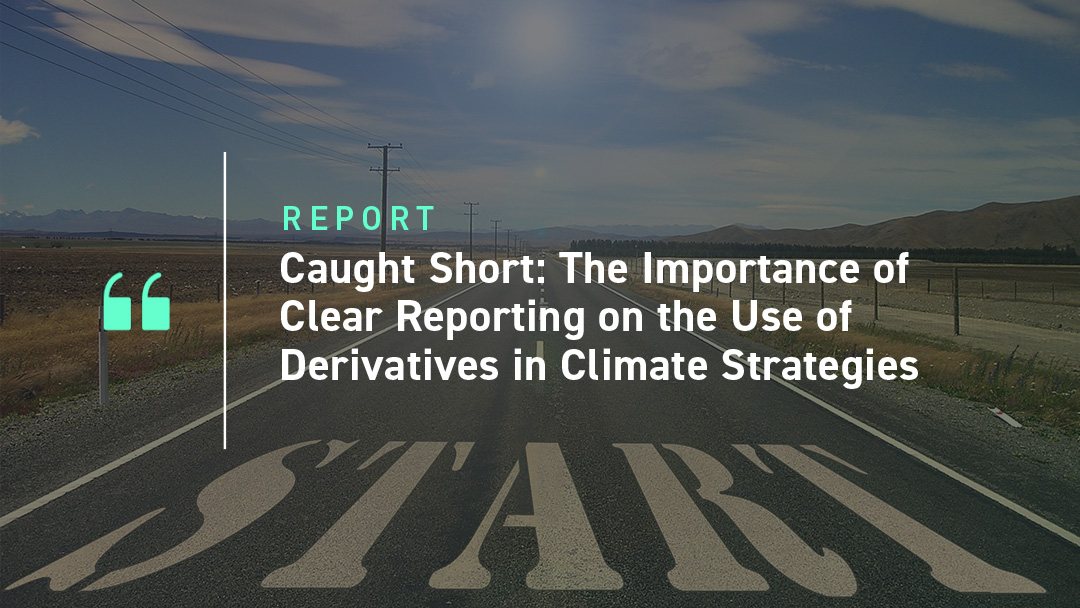Short selling refers to securities trading activities that position an investor to benefit from a fall in a stock’s price. The use of this tactic as a tool to manage climate risks has been a hot topic recently.
Shorting Climate Change?
Some investors are reporting near-zero portfolio emissions after using shorting tactics to net out the greenhouse gas production of the companies they invest in. From an accounting perspective this can make theoretical sense. Unless this number is presented transparently and in context with real world impacts, however, an observer may be fooled into believing that the investor managed to remove Greenhouse Gases (GHGs) from the atmosphere simply by shorting. This is not the case. The real-world environmental impacts of a shorting strategy are potential, and inevitably, always in the future.

Regulatory frameworks often require investors to express their climate impact through traditional carbon intensity metrics. This is particularly difficult when looking at shorts and derivatives that are used to hedge risk and to express beliefs about particular stocks. As shorts are based on the idea that an underlying security might decline in value, their most basic form revolves around selling a borrowed stock in the hopes of being able to buy it back more cheaply before having to return it. The shorting community is doing their best to express this approach in the context of carbon accounting, but there is a risk that the resulting metrics don’t capture the intricacies of the financial instruments involved.
To understand the relationship between shorting and greenhouse gas (GHG) accounting, the questions we need to ask are the following:
Is shorting a strategy that can help manage climate risk? Yes.
Can a shorting strategy’s risk exposure be expressed via GHG accounting? Yes.
Can a shorting strategy have a positive impact on climate change? Yes, theoretically.
Can this impact be calculated via greenhouse gas accounting? No.
What is Greenhouse Gas Accounting and What Does It Tell Us?
The purpose of greenhouse gas accounting is to quantify the emissions of GHGs from, for example, corporate activities, projects, products, or investments. There are several standards available in the market outlining how this should be done in a credible way, the most widely used being the GHG protocol. The GHG protocol allocates emissions into scope 1, scope 2, and scope 3 emissions. These divisions indicate responsibility and ownership for emissions throughout the value chain. In addition to the GHG protocol, the Partnership for Carbon Accounting Financials (PCAF) provides further guidance with its Global GHG Accounting and Reporting Standard for the Financial Industry. No guidance is currently available for shorts and derivatives.
Traditionally corporate GHG accounting is used to express impact ex post. Impact in a climate context refers to causal relationships in a process that has direct influence on the environment. A popular example would be the combustion of fossil fuels increasing the amount of carbon dioxide in the atmosphere. Beyond impact, GHG accounting can also be used as a rough proxy for risk exposure: high emissions equal high risk, for instance, and vice versa.
Longs, Shorts and Derivatives
Long positions are generally based on the conviction that the underlying asset will generate returns from value appreciation, dividends and other carry benefits that exceed the returns of a risk-free investment. Long positions also allow engagement with the respective holdings, including shareholder resolutions and votes on climate-related issues at company Annual General Meetings. While many portfolios are long-only, there are various other tools that are useful in modifying portfolio exposure to climate and other risks.
Let’s assume for example that an investor is holding shares in an oil and gas company. Given regulatory initiatives such as carbon taxation, the investor now believes that the company’s oil reserves are incorrectly valued on its balance sheet. As a result, they believe that the intrinsic value of the company is significantly lower than its market value.
The easiest way for them to deal with this situation is divestment. This move might result in limited downward pressure on the market price, but will not enable the investor to further engage with the company in a meaningful way.
A more consequential approach would be to not only divest, but to also establish a short position. This would provide downside protection as well as a potential contribution to increased costs of capital for the respective company, as well as enabling the investor to profit if their beliefs are accurate.

Further, shorts could be leveraged for climate arbitrage strategies. In this approach, an investor establishes a market-neutral portfolio consisting of long positions in companies that are actively reducing their carbon-related risk, and short positions in companies that do not. Over time, as performance of the companies diverges, investors may enjoy returns without being exposed to market risk. Similarly, derivatives such as futures, warrants, and swaps, can be used to modify the exposure of an investor’s portfolio to climate-related and other risks, both for hedging and speculative purposes.
None of these tools should simply be treated as a long position when calculating a portfolio’s overall carbon footprint, however. And nor can they be considered to have real-world impact on the amount of carbon being emitted into the atmosphere.
Different Philosophies on Carbon Accounting
Taking a step back, the GHG protocol focuses on a ‘control’ approach when it comes to determining ownership. With shares being borrowed and shorted, this approach becomes difficult to implement. Consider a normal shorting situation where investor A lends their shares to a short seller who then sells the shares to investor B. While both investors would benefit from stock appreciation, only investor B is entitled to vote and hence able to exert control. Accordingly, only investor B should account for the financed emissions.
This is generally not what is happening in the market, however – in practice both investors would add the position to their portfolio emissions, risking the double counting of the holding emissions. Thus, for the sake of internal consistency, the accounting equation needs to be balanced by accounting for the short position as a net negative.
Looking at accounting from a risk perspective makes this approach even more intuitive: investors A and B have positive risk exposure while the short seller has negative risk exposure. Hence, A and B should report positive emissions, while the short seller should report negative ones.
Similar approaches can be taken to other derivatives. In the case of total return swaps, for example, the long position does not exert control, but they are exposed to risk, while the short position usually hedges their exposure by buying the underlying asset. From an accounting perspective, the financed emissions should be allocated to the long position and not the short. Any other approach would not only lead to inconsistencies with regard to the accounting equation, but also to perverse incentives. If control is needed for allocation of emissions, there is an incentive to gain exposure to carbon-intensive companies through tailored financial instruments rather than stock or bond issues. This would enable investors to claim low emission intensities while at the same time potentially profiting from brown revenue.
Investors Accounting for Climate Change
Climate-aware investment strategies can incorporate approaches that seek to reduce investment risk, reduce overall climate impacts, or both – the ISS ESG Climate Solutions team works with clients to implement strategies right across this spectrum.
Shorting can play a role in a risk-based approach, by minimizing the investment risks associated with climate change. An impact-focused approach instead priorities achieving real world outcomes by, for example, investing in technologies that help reduce emissions.
If one wished to use GHG accounting as a risk metric, such as by equating high emissions with high risk, a netting approach could make sense, as what you wish to communicate is not real-world outcomes, but rather a metric that reflects the hedged approach to emissions exposure. If supporting impact is the goal of the portfolio, however, the metric is misleading. The shorter may be removing theoretical emissions from the balance sheet, but not removing emissions from the atmosphere – by going short on Volkswagen you are not removing cars from the road! And a balance sheet claim of moving the economy towards Net Zero serves no purpose without a real-world impact.
The challenge of impact reporting is not exclusive to shorts, many of the reporting frameworks available for investors today do not cover the intricacies of all financial instruments. What is key for all investors who wish to have a credible strategy is transparent communication about their climate targets and how they intend to reach them. Shorting can be a useful tool to manage portfolio climate risks, but ultimately does not deliver the real-world outcomes that many investors are looking for.
Explore ISS ESG solutions mentioned in this report:
- Use ISS ESG Climate Solutions to help you gain a better understanding of your exposure to climate-related risks and use the insights to safeguard your investment portfolios.
- Develop engagement strategies, define achievable engagement objectives and manage your engagement process with the ISS ESG Engagement Service.
By Fredrik Lundin, ISS ESG Head of R&D Climate. Steffen Bixby, Head of US Climate Analytics, ISS ESG Climate Solutions.




